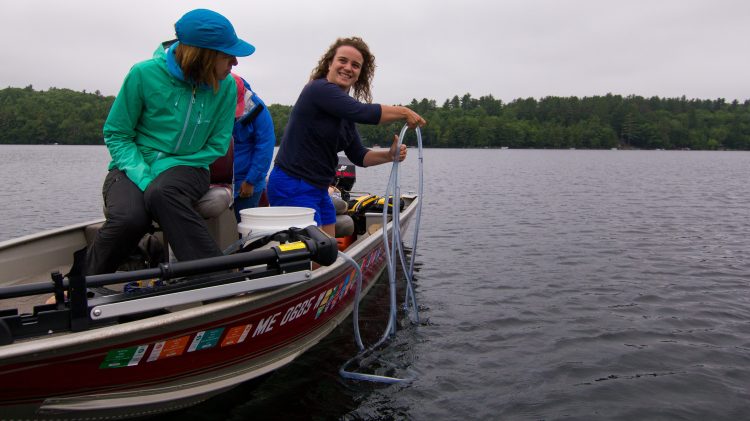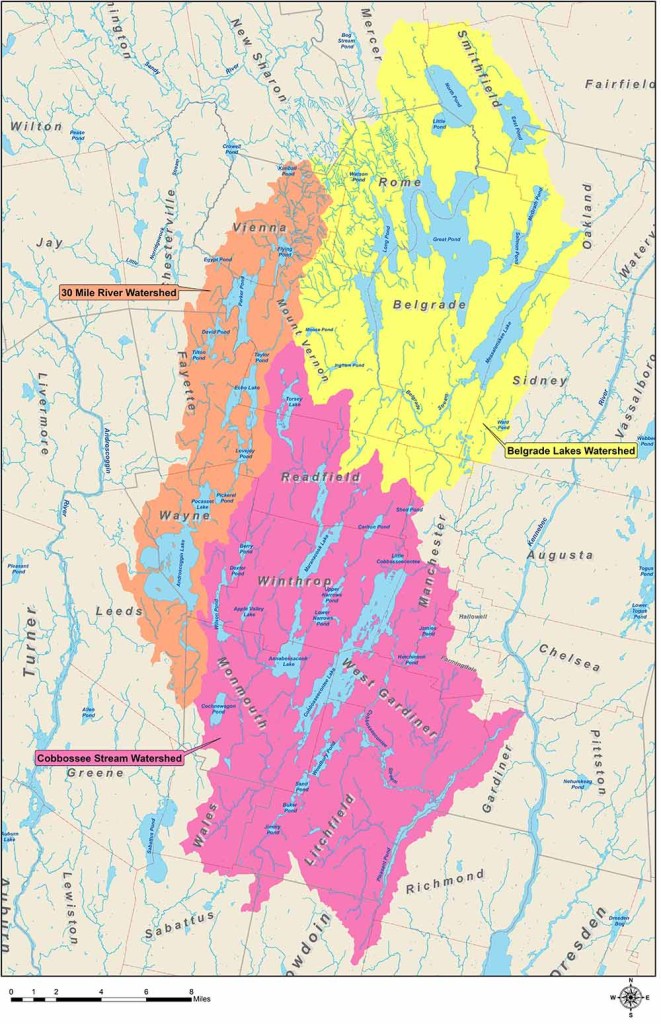Spring is just around the corner. The snow showers are slowly turning into rain. Grass is finally exposed on our lawns. Wildlife has come out, bringing song birds, foraging squirrels and sleepy skunks. This warmth will also bring year-round citizens and tourists alike to our inland waterways, for boating, swimming, fishing, and water sports. There is no question that these lakes, rivers, ponds and streams are clean and pristine reflections of Maine’s natural beauty. Have you ever stopped and asked yourself “Why are these waterways so clean and beautiful?”
Your answer largely lies in the efforts of environmental organizations around the state. In Central Maine, there are predominantly three water quality organizations that work with a mission to keep our waterways clean and healthy through the changing times. These water quality groups are: Friends of the Cobbossee Watershed, 30 Mile River Watershed Association, and the Belgrade Regional Conservation Alliance. These groups are independent nonprofits, but they work together to achieve the same results. The work of these water quality organizations is vital to the health of the ecosystems that we cherish in Maine
The issues these organizations have come together to address come with their own complexities. “The two biggest threats to our waterways… are invasive aquatic species (including plants, fish, and other critters), and increased nutrients due to erosion and run-off. This leads to algae blooms and decreased dissolved oxygen, which can be fatal for many cold-water fish species,” Toni Pied from the Belgrade Regional Conservation Alliance wrote when discussing the work that her and her colleagues are involved in.
“Invasive species are a threat to our environment because they can alter the balance of an ecosystem. Non-native invasive species have no natural predators or pathogens to keep them in check. This causes native species to be excluded from their natural habitat, leads to a loss in biodiversity, and can also be a major threat to species that are already on the brink (endangered or threatened species),” said Pied.
Pied continued to explain that “Increased nutrients due to runoff and erosion are a big problem in our lakes because this can lead to increased levels of phosphorous.” Nutrients like phosphorus, which are naturally occurring in our water help to dictate the levels of algae in our water. The more phosphorus, the more algae. This “can lead to issues related to water clarity, available dissolved oxygen (which fish and other species need to survive), and increased levels of cyanotoxins,” said Pied.

Belgrade Regional Conservation Alliance Milfoil Team
Threats like these unfortunately loom over the waterways in Maine. According to the Maine Department of Environmental Protections, as of January of 2017, 49 bodies of water in the state of Maine have invasive plants in them. These infested lakes are all south of Benton, and span in all directions below it. Luckily, invasive species have not spread through all bodies of water in the state. To make this a long-term reality, controlling the spread of these organisms rests on the shoulders of water quality groups in southern and central Maine.
“We see… how imperative it is that we protect and improve our water quality,” said Tamara Whitmore from The Friends of the Cobbossee Watershed. “Four of the twenty-one lakes and ponds on the Maine DEP Impaired Lakes list are in the Cobbossee Watershed (Annabessacook, Cochnewagon, Pleasant and Wilson). Another 13 of our lakes and ponds are on the “threatened” list, resulting in 17 out of our 28 major lakes and ponds in the Cobbossee Watershed listed as either “impaired” or “threatened” [and] we perform over 10% of the entire State’s courtesy boat inspections every year.”
Water quality groups cannot do their work without the support of their communities.
“Citizens (both year-round and summer residents) who were concerned about the declining water quality in our lakes, ponds, and streams started our organization. Our ‘citizen heroes,’ [are] people like… Jay Snider, Allen Ryan, Conrad Ayotte, and Jeff Timm, [who] have been extremely important in getting our organization off the ground. In addition, of course, Clark Marine has been one of our biggest supporters over the years, taking care of the OTTER II, our ‘floating classroom’ and outreach vessel, and our Diver Assisted Suction Harvester, which we use to remove invasive aquatic plants. The mechanics and boat technicians at Clark keep our boats running in all sorts of conditions, winterize and maintained our boats and help us problem solve at every turn. We couldn’t do our work without our friends at Clark Marine!” said Whitmore.

Diver Assisted Suction Harvester from the Friends of the Cobbossee Watershed
“I have always believed strongly in the mission of the local water quality groups. That is why we always do what we do. We are fortunate to have a staff that shares those same beliefs. Anything we can do as a company to forward the mission of these essential groups; we are all in!” said Rob Brown, a co-owner of Clark Marine. “We do everything we can to remove the ‘on the water’ costs for the water quality groups. This includes providing free storage, repairs and deliveries. Over the years we have donated equipment, coast guard gear, parts and accessories, and sometimes man power. We have even helped to dispose of milfoil from the Friends of the Cobbossee Watershed’s Dash Boat– which was largely assembled at our Monmouth facility. Whenever there is a need, we do our best to say yes.” said Brown.
“We are extremely grateful for the support Clark Marine has provided every year since we began back in 2008, from servicing and storing our boat, to being the lead sponsor on our annual Paddle Trek, to providing a boat for our water quality monitoring program.” said Lidie Robbins of the 30 Mile River Watershed Association.
Even though the environmental issues are vast, all groups cited funding and finding volunteers as their largest struggles.
“Fundraising is definitely our biggest challenge. We are a private nonprofit and every year we must raise all the funding to run our programs. We seek funds from towns, lake associations, private and government grants, corporations, and individuals. 80% of what we raise goes directly to our programming.” Said Robbins from the 30 Mile River Watershed Association.
“We do an incredible amount of work with a minimal budget. We wring every penny out of every dollar donated to our work, and are always striving to become more efficient, while having a greater impact.” Said Whitmore
If you want the help these organizations, the best way to make an impact is to donate your time by volunteering as a courtesy boat inspector and supporting their fundraising efforts. You can also donate money and encourage others to do the same. “In-kind support is a great way to help many non-profits. This might be the donation of goods and services, or volunteering your time. Becoming a member is also a great way to support BRCA,” said Pied.
Along with that, “Boaters can make a big difference by getting in the habit of very carefully checking their boats, trailers and gear for hitchhiking aquatic plants, every time they use their boats, both before launching and after they pull out. Although we have courtesy boat inspectors (CBIs) to help with this task, CBIs aren’t staffing the launches all the time,” said Robbins
This summer Clark Marine will be expanding these philanthropic efforts for the water quality groups in Central Maine. They will have donation buckets at all events from now through the end of the summer. These events will range from “Parking Lot Parties” to some on-the-water bashes. If you are interested in attending any of these events, “like” Clark Marine on Facebook, or check out their website for more information.
If you would like to donate to any of the water quality groups you can follow the links below:
Belgrade Regional Conservation Alliance
https://www.sagepayments.net/eftcart/forms/donate.asp?M_id=137589773148
Friends of the Cobbossee Watershed
www.watershedfriends.com or www.facebook.com/spottertheotter/
Thirty Mile River Watershed Association
http://www.30mileriver.org/get-involved/donate/
If you would like to learn more about any of these water quality groups, or ways that you can volunteer with them check them out at:
http://www.watershedfriends.com/
Maine Department of Environmental Protections Invasive Aquatic Plants Map: http://www.maine.gov/dep/water/invasives/invasivesmap.pdf
Copy the Story LinkSend questions/comments to the editors.




Success. Please wait for the page to reload. If the page does not reload within 5 seconds, please refresh the page.
Enter your email and password to access comments.
Hi, to comment on stories you must . This profile is in addition to your subscription and website login.
Already have a commenting profile? .
Invalid username/password.
Please check your email to confirm and complete your registration.
Only subscribers are eligible to post comments. Please subscribe or login first for digital access. Here’s why.
Use the form below to reset your password. When you've submitted your account email, we will send an email with a reset code.